The Razer Blade Stealth Review: Razer Takes On The Ultrabook
by Brett Howse on March 29, 2016 8:00 AM EST- Posted in
- Laptops
- Razer
- Skylake
- Razer Blade Stealth
- eGFX
- Razer Core
- Skylake-U
Display
Razer offers two displays in the Stealth. The lower priced offering is a QHD 2560x1440 panel, which is typically the higher resolution offering on most Ultrabooks. With the 12.5-inch screen, that makes for a respectable 235 pixels per inch. For most notebook tasks, this works well. The default DPI setting is a custom level slightly under 175%, which works well for the screen size. The QHD panel offers 100% sRGB gamut coverage.
However for those that want to take it to eleven, Razer will outfit the higher end models of the Stealth with a UHD 3840x2160 display. Considering the compact 12.5-inch screen, that works out to a smartphone-esque 352 pixels per inch. Razer isn’t the only company to offer UHD at this screen size, but it does put them right at the top of the heap when it comes to pixel density on a notebook. I’ll admit I was skeptical that this was necessary, because there are certainly downsides of such a high resolution as well, but seeing both units side by side, I can pretty easily see how much sharper the UHD model is even with my old eyes. The UHD display also covers 100% of the much larger Adobe RGB color space.
Here is kind of where we run into an issue though. Most notebooks that offer 100% Adobe RGB color space support also offer a way to switch the notebook from one color space to another – namely the sRGB color space – which is what is used for most of the web and many applications, while the wider gamuts are for use when needed for doing photo work in color space-aware applications. That is not the case with the Stealth though. It offers no extra functionality for this and that means it is in Adobe RGB mode all the time.
Now, it’s easy to fault Razer here, and of course they should have provided an sRGB if they were going to go down this path. Since pretty much everything is created for sRGB, viewing sRGB images on an Adobe RGB gamut display can cause duller images that you would expect, which is kind of the opposite result that you would want. The Adobe RGB color space is much more vibrant than sRGB and viewing appropriate images in Adobe RGB is very appealing. However, we are kind of at a transition point where sRGB is what most things are, but we are finally getting LED based monitors which can cover a wider gamut.
The real solution here is that Windows 10 needs to do a better job with wide gamut displays and correctly mapping a sRGB image into the wider space, but at the moment it doesn’t do that. We’ve seen a rise in standards which require a wider gamut, like DCI-P3 and the very wide Rec. 2020, but Windows’s handling of these makes it very much up to the application. Hopefully we’ll see some movement there from Microsoft.

Example of Adobe RGB Color Space
With that preamble out of the way, let’s get down to the displays themselves. Razer includes a default icc profile for their panels, which can help with the grayscale and color temperature. It’s the next best thing behind individually calibrating the panels, and because it is a generic profile it won’t mask issues with individual panels. The QHD model was tested against sRGB and the UHD model was tested against Adobe RGB. Contrast and brightness were measured with an X-Rite i1Display Pro colorimeter, and color accuracy was tested with an X-Rite i1Pro2 spectrophotometer. SpectraCal’s CalMAN 5 suite was used with a custom workflow.
Brightness and Contrast
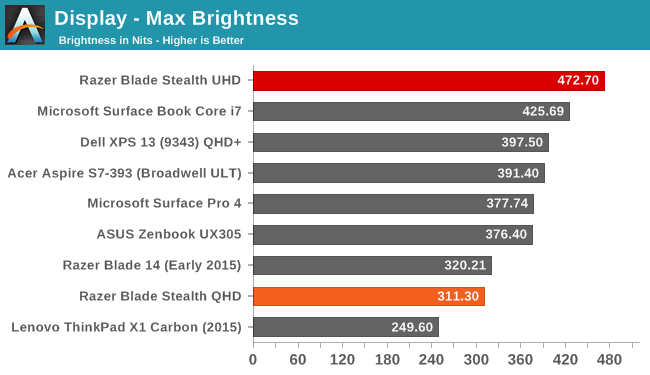
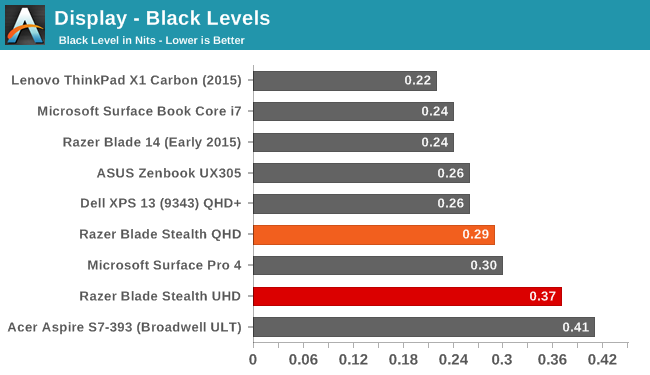
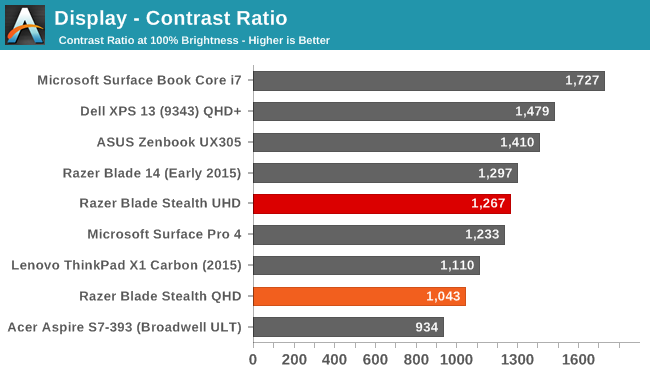
Both panels do well here, but the UHD one is amazingly bright. In fact I'd say that it's almost smartphone bright. It’s not every day a laptop that can hit almost 500 nits lands on my desk, and the excellent thing is that it hits this very high brightness level, but also keeps the black levels reasonably in check. 1200:1 contrast is not chart topping, but it’s still very good for a laptop LCD.
Grayscale and White Point


Out of the box, the Razer default ICC profile is available to help correct temperature and grayscale. On the two models I had, the grayscale was not as accurate as I’ve seen in other products from Razer, which due to them not individually calibrating each display. A generic profile can only do so much. What it did help with a lot though was the color temperature. On the QHD version, removing the ICC profile would make the display a lot cooler. Regardless there’s room for improvement here from Razer. Luckily this is the one area where a display calibration can make the most impact. The QHD model in particular had some issues very early in the range.
Saturation
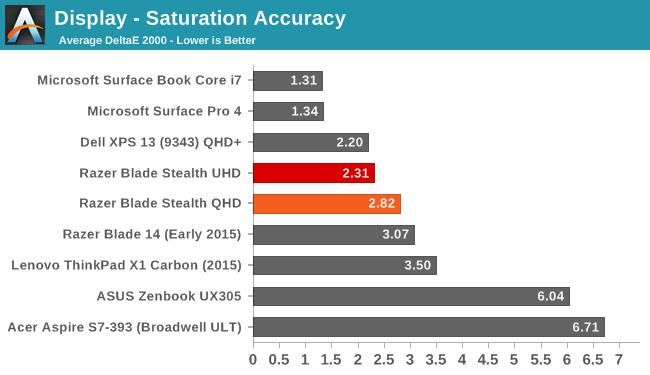
Luckily the issues with grayscale were relegated to just that. On the saturation sweeps, the display is much more accurate in the target color space. Here it is clear how much larger the color space is on the UHD model. Both displays can pretty much hit the entire gamut they are targeting, whether it be sRGB on the QHD one or Adobe RGB on the UHD display.
Gretag Macbeth

The most comprehensive test is the Gretag Macbeth colorchecker, which tests a wide range of colors including quite a few of the flesh tones. Both displays do ok here, with the UHD model coming in a bit better again.
Color Comparator
To get a feel for what the numbers mean, the following images are relative color comparisons, with the target color on the bottom half of the swatch. This is relative because any inaccuracies in your own display will skew the target color, but it does put a visible difference on what the results of the display testing mean.
Both QHD and UHD displays are off when it comes to the gray tones, as expected with the earlier grayscale results, but the colors are more in-line with what they should be.
Display Conclusion
It’s great to see Razer continue their partnership with Sharp and include IGZO-based LCDs in both models. The IGZO displays continue to offer great color reproduction, and the more transparent TFT of IGZO lets plenty of the backlight through. Hitting almost 500 nits is impressive, and at a pixel density of 352 pixels per inch, it’s even more impressive.
That being said, the included ICC profiles did not correct for grayscale, and both the QHD and UHD versions need some help on that. Clearly Razer was aggressively targeting a price point, but both of the displays are nowhere near where they should be on gray.
The final piece is the Adobe RGB support on the UHD model. Until such a time as Windows can properly handle larger gamut displays, it would have been prudent to include software to pick the color space as necessary. Having only Adobe RGB support is not ideal in our current sRGB world.


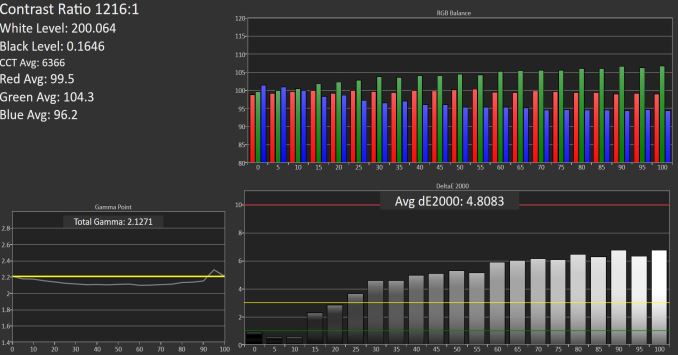
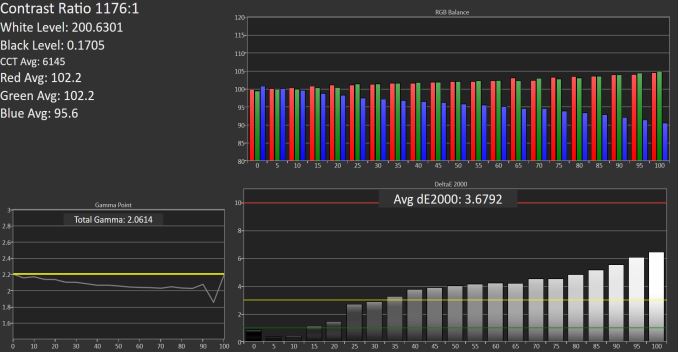
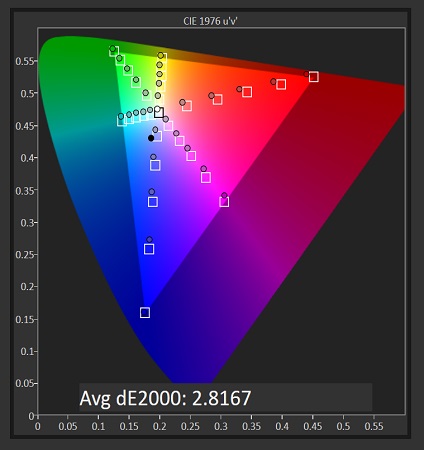
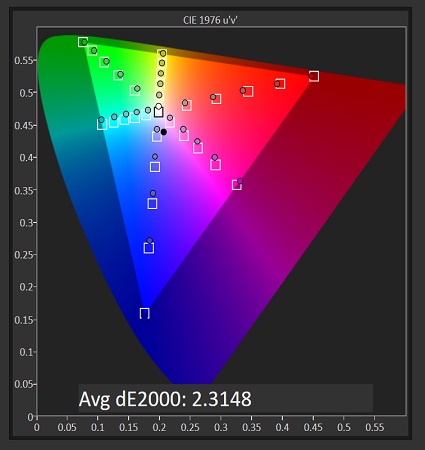
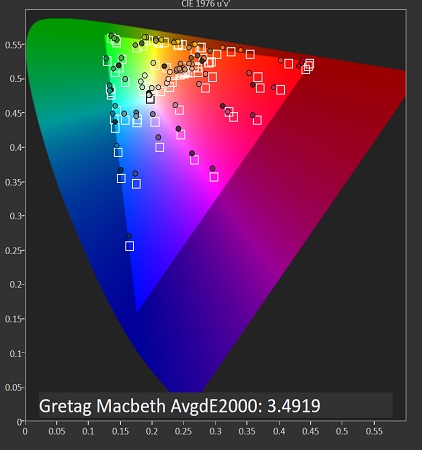
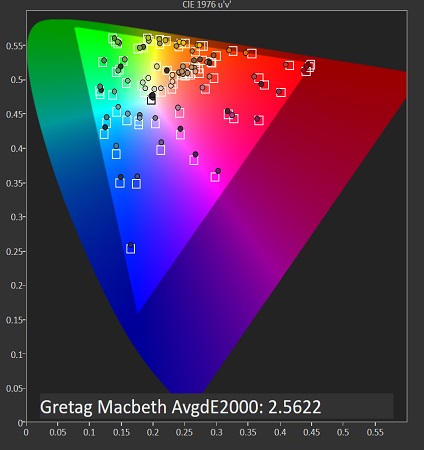












66 Comments
View All Comments
forgot2yield28 - Thursday, March 31, 2016 - link
Won't benefit the end user? Are you kidding? If you do any kind of work viewing fine vector images, such as architectural displays, a high DPI display is a godsend. For productivity software, if you have good eyesight and don't mind shrunken UI elements, you fit your work on more of the screen. It's obviously a tradeoff against battery life, but it's a tradeoff some would gladly make. It's simply not true to state there are zero use cases where a high DPI display provides a tangible benefit.niva - Friday, April 1, 2016 - link
You can disagree all you want, but anything below 1080p should be immediately disqualified from being purchased 5 years ago. An argument about 1080p for the sake of efficiency can be made, but discouraging companies from adopting higher resolution standards is just wrong. The UHD display can be ran as a 1080 for performance purposes.moozooh - Saturday, April 2, 2016 - link
> An Intel GPU in a 12.5 inch laptop display that is unable to drive games at much lower resolutions should be paired with a 1366x768 panel of decent quality with good viewing angles.That is just silly. Gaming performance is never a goal with laptops of this form-factor, not even a secondary one. If you're looking for any kind of decent gaming performance you shouldn't be considering an Ultrabook at all. Their primary task is the ability to handle large amounts of text, non-computanionally-intensive media work, and internet browsing/media consumption on-the-go for as long as possible without having to be plugged in. The difference between a 120 dpi panel and a 190+ dpi panel when working with text or photos is MASSIVE. They aren't even comparable, not if you value your eyesight and comfort at all. Had you experienced that you would never write the nonsense about 768p panels.
deeps6x - Wednesday, April 6, 2016 - link
Which is why they should have had a 1080P option with a nice Matte IPS screen. 13.3", not the micro size they went with. It fits. Use it Razor. You build this fine ass machine then gimp it with the large bezels. If Dell can do it you can do it as well, if not better.Why 1080P? Because it uses less power than 3k or 4k, and extends battery life. Why matte screen? Because touch is Intel forced cow poop, and I like to be able to use my laptops with windows behind me. Or even outside. I don't know what kind of profit Intel makes by insisting touch screens are part of the 'Ultrabook' spec, but it is one of their dumbest ideas ever. Touch on a tablet? Of course. Touch on a laptop? Useless.
jlabelle - Thursday, April 28, 2016 - link
- Higher resolution displays, while nice looking, offer little to no added functionality after reaching the point -So...it does !
And let's be honest, we are still far from smartphone resolution. I am not pushing for 4K display on a 12" screen but there is a CLEAR difference between 768p and QHD on such size.
- after reaching the point where it becomes necessary to scale the interface in order to retain visibility of objects displayed in it -
Which is not a issue per see. Windows Store applications and UI just scaled perfectly. It is old legacy software that needs to be adapted for that so indeed, it is a good thing to evolve in this direction to force the software manufacturer to make their homework as high DPI support exists on Windows since more than 7 years.
- Anything more than that won't benefit the end user regardless of how much they think they need more pixels.-
It does. What does NOT is the aRGB screen, which, as explained, for most of the operation is detrimental to the user experience.
mikesackett.85 - Thursday, March 31, 2016 - link
768 is awful, 1080p should be the minimum. Having been spoiled by nice high DPI screens (1600-1700p) I'll never go back to anything less than FHD. For me the QHD model hits the sweet spot at $999.99, for that you get an i7, 8GB Ram, 128GB SSD, and QHD touchscreen, which is higher specs than the similarly priced XPS 13 (i5, 1080p, 8GB RAM, 128GB SSD, non-touch) and a similar specced MBP is $1299. This laptop also has the added bonus of having a thunderbolt connected dGPU which none of the other options have (Though the Razer dock should work on other pc's with thunderbolt ports, including the Dell XPS 13). This laptop has the ability to serve both as a road warrior and in-home gaming machine, for that I feel it is absolutely worth the price of admission.Kristian Vättö - Tuesday, March 29, 2016 - link
I agree. The battery life is a big drawback considering that the competitors offer nearly twice the battery life.A part of my wonders why won't Razer offer a model for the normal consumer. Kill the fancy keyboard backlight and offer i3 and i5 CPUs, and the Stealth could be very competitive against the likes of Dell and ASUS. I know Razer is all about gamers, but the Stealth looks like a very solid machine and given Razer's higher-end brand status and quality I'm sure they could reach a wider audience with just a few small tweaks.
zeroqw - Tuesday, March 29, 2016 - link
Exactly. I have been monitoring the ultrabook market for 2 years and to be honest this laptop could have been a big hit with real battery life. It feels like all the ultrabook laptops got some smaller or bigger drawbacks and you just cant get what you pay for. I just hope they consider moving closer to a wider audience in the future.nerd1 - Tuesday, March 29, 2016 - link
They can provide FHD (matte) screen with i5 version at $799, which should last twice longer than this.ImSpartacus - Tuesday, March 29, 2016 - link
Since at first glance, it appears that Razer is emulating parts of Apple's strategy, I would guess that Razer is ensuring that every modern system in the Razer "ecosystem" can have a satisfactory experience with their Core.The Blade 14 & 17 are both easily up for the task. And Razer at least attempted to ensure that every Stealth will be a good match for the Core. However, if they put a weaker 15W CPU in there, then it might not perform as well with the Core.
Is that the right thing to do? Objectively no, but I wonder if that kinda of Apple-esque way of thinking of part of the reason why the Blade laptops seem to be so cool in the first place. You take the good with the bad, I guess.